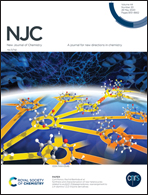Molecular docking-assisted design and synthesis of an anti-tumor quercetin–Se(iv) complex†
Abstract
The pharmacological and therapeutic activities of flavonoids and their derivatives have been widely studied. In particular, flavonoid–metal ion complexes exhibit improved anti-tumor activities compared with the parent flavonoids. In this paper, we reported a quercetin–Se(IV) complex (QUE-Se) that was designed by molecular docking and synthesized based on the DNA binding activity. Molecular docking was used to visually analyze the interaction affinity between QUE-Se and DNA. Then, the aimed complex was synthesized under the guidance of DNA binding activity. According to the principle of DNA rolling circle amplification at the molecular level, the biological activity of QUE-Se bound DNA was visualized by gel electrophoresis imaging. Interestingly, QUE-Se was intercalated in DNA to induce conformational changes, which significantly inhibited DNA amplification in vitro, and then stabilized the structure of the G-quadruplex. Moreover, QUE-Se could be taken into cells and accumulated in the nucleus, followed by arresting the tumor cell cycle and promoting their apoptosis. QUE-Se also exhibited better DNA binding activity than quercetin, with an 8-fold enhancement in cytotoxicity against the MCF-7 cell line. In conclusion, QUE-Se, a multinuclear organoselenium complex, would be a potential candidate for DNA-targeted cancer treatment. This research provided a significant strategy for the design of DNA-targeting anti-tumor drugs.



 Please wait while we load your content...
Please wait while we load your content...